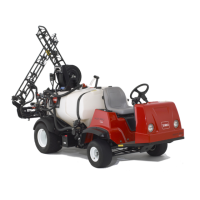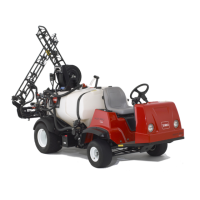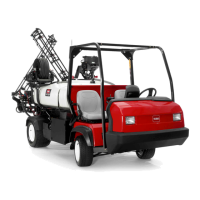Multi Pro 1750
Page 5 − 55
Electrical System
Pump Drive Electric Clutch
An electric clutch is used to engage and drive the spray
pump on the Multi Pro 1750. The electric clutch is
mounted on the spray pump input shaft. Clutch opera-
tion is controlled by the pump switch located on the con-
trol console. The pump switch is an input for the Toro
Electronic Controller (TEC), therefore, the clutch en-
gages when current is applied to the clutch coil by the
TEC (output). When engaged, the clutch allows the en-
gine driven sprocket and drive belt system to rotate the
spray pump for sprayer operation.
Testing
1. Park machine on a level surface, stop spray pump,
stop engine and engage parking brake. Remove key
from ignition switch.
2. Locate clutch on spray pump shaft. Carefully unplug
machine wire harness connector from clutch terminals
(Fig. 74).
NOTE: Prior to taking small resistance readings with a
digital multimeter, short the meter test leads together.
The meter will display a small resistance value (usually
0.5 ohms or less). This resistance is due to the internal
resistance of the meter and test leads. Subtract this val-
ue from from the measured value of the component you
are testing.
3. For accurate clutch resistance measuring, clutch
should be at approximately 70F (21C). Using a multime-
ter (ohms setting), verify clutch coil resistance between
the two (2) terminals of the connector. Clutch coil resist-
ance should be from 2.9 to 3.2 ohms.
4. If clutch coil resistance is incorrect, replace clutch.
5. .As an additional test, apply 12 volts to the terminals
of the clutch. The clutch should engage. If clutch does
not engage when voltage is applied, replace clutch.
6. If the clutch tests correctly and a circuit problem still
exists, check wire harness (see Electrical Schematic
and Wire Harness Drawings in Chapter 10 − Electrical
Drawings in this manual).
7. See Pump Drive Electric Clutch in this chapter if
clutch removal is necessary.
8. After testing is completed, plug machine wire har-
ness connector onto clutch terminals.
1. Electric clutch 2. Clutch terminals
Figure 74
1
2

